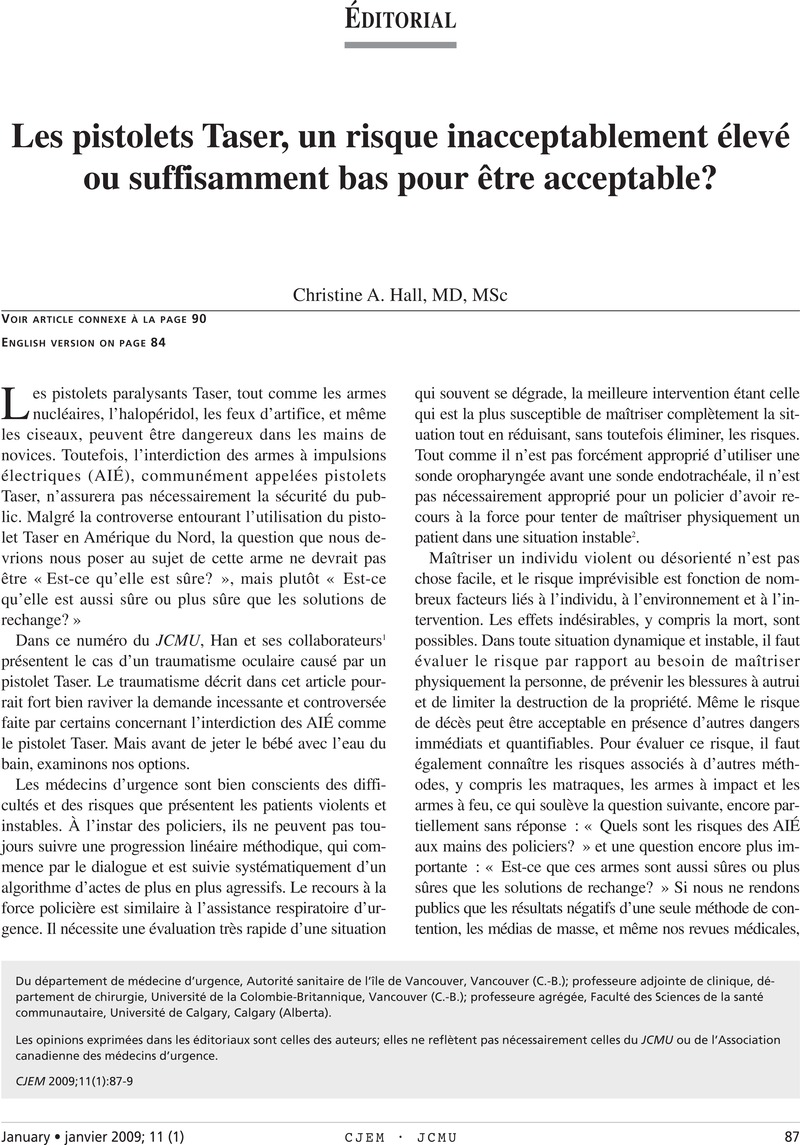No CrossRef data available.
Article contents
Les pistolets Taser, un risque inacceptablement élevé ou suffisamment bas pour être acceptable?
Published online by Cambridge University Press: 21 May 2015
Abstract
An abstract is not available for this content so a preview has been provided. As you have access to this content, a full PDF is available via the ‘Save PDF’ action button.

- Type
- Éditorial
- Information
- Copyright
- Copyright © Canadian Association of Emergency Physicians 2009
References
Références bibliographiques
1.Han, JS, Chopra, A, Carr, C.Ophthalmic injuries from a TASER. CJEM 2009;11:90–3.CrossRefGoogle ScholarPubMed
2.Canadian Association of Chiefs of Police, Board of Directors. A national use of force framework. Ottawa (ON): The Association; 2000. Disponible sur :http://ilecnet.org/Standards/Canada%20National%20Use%20of%20Force%20Model%202000.pdf (consultè le 24 novembre 2008).Google Scholar
3.Bozeman, WP, Winslow, JE, Hauda, WE II, et al.Injury profile of TASER electrical conducted energy weapons (CEWs). 39th Scientific Assembly of the American College of Emergency Physicians. Seattle (WA): Oct 8–11, 2007.Google Scholar
4.Butler, C.Force Science News # 102. Mankato (MN): Force Science Research Center; 2008. Disponible sur :http://www.force sciencenews.com/home/current.html (consulté le 24 novembre 2008).Google Scholar
5.Amnesty International. Amnesty International’s continuing concerns about taser use.London (UK): Amnesty International; 2008. Disponible sur :http://www.amnesty.org/en/library/asset /AMR51/030/2006/en/dom-AMR510302006en.pdf (consulté le 24 novembre 2008).Google Scholar
6.American Civil Liberties Union. Citizen deaths in police custody, ACLU of Colorado call for limits on use of electroshock weapons. New York (NY): The Union; 2004. Disponible sur :http://www.aclu.org/crimjustice/gen/10119prs20040226.html (consulté le 24 novembre 2008).Google Scholar
7.Nanthakumar, K, Billingsley, IM, Masse, S, et al.Cardiac electro-physiological consequences of neuromuscular incapacitating device discharges. J Am Coll Cardiol 2006;48:798–804.Google Scholar
8.Dennis, AJ, Valentino, DJ, Walter, RJ, et al.Acute effects of Taser X26: discharges in a swine model. J Trauma 2007;63:581–9.Google Scholar
9.Kiedrowski, J, Petrunik, M, Melchers, R.Examen indépendant de l’adoption de l’arme à impulsions et de son utilisation par la Gendarmerie royale du Canda. Ottawa, Ontario: Gendarmerie royale du Canda; 2008. Disponible sur :http:// www.rcmp-grc.gc .ca/ccaps/cew/kiedrowski_report_f.htm(consulté le 24 novembre 2008).Google Scholar
10.Communiqué de la Commission d’enquête Braidwood. Victoria, C.-B. : Province de la C.-B.; 2008. http://www.braidwoodinquiry.ca/Google Scholar
11.Breitkreuz, G.Rapport du Comité permanent de la sécurité publique et nationale : Étude sur l’arme à impulsions électriques TaserMD. Ottawa, Ontario. Chambre des communes Canada; 2008. Disponible sur :http://www2.parl.gc.ca/Content/HOC/Committee/392/SECU/Reports/RP3582906/392_SECU_Rpt04_PDF/392_SECU_Rpt04-f.pdf (consulté le 24 novembre 2008).Google Scholar
12.Luceri, RM.An open letter to the law enforcement community. Florida Arrhythmia Consultants. J Am Coll Cardiol 2007;49:732.Google Scholar
13.Kroll, MW, Calkins, H, Luceri, RM.Electronic control devices and the clinical milieu. J Am Coll Cardiol 2007;49:732–3.Google Scholar
14.Kroll, MW, Calkins, H, Luceri, RM, et al.Electronic control devices. CMAJ 2008;179:342–3.Google Scholar




